It was a little thing but it was a behavior I hadn’t seen before.
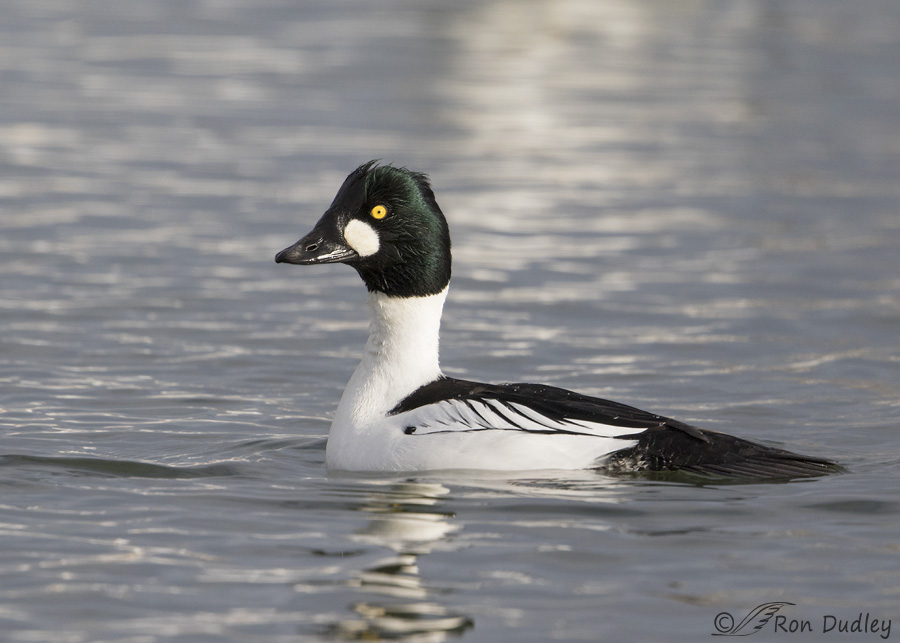
1/2500, f/6.3, ISO 500, Canon 7D Mark II, Canon EF 500mm f/4L IS II USM + EF 1.4 III Extender, not baited, set up or called in
Yesterday afternoon I spent some time at my neighborhood pond photographing Common Goldeneyes. Much of the pond is iced over so large numbers of birds (mostly hybrid ducks, coots, gulls and geese) are largely confined to relatively small areas of open water. There were bursts of excitement on the pond because every time one of the goldeneyes would surface with food hordes of gulls would rush in and try to steal it. Perhaps that explains the alert pose of this adult male.
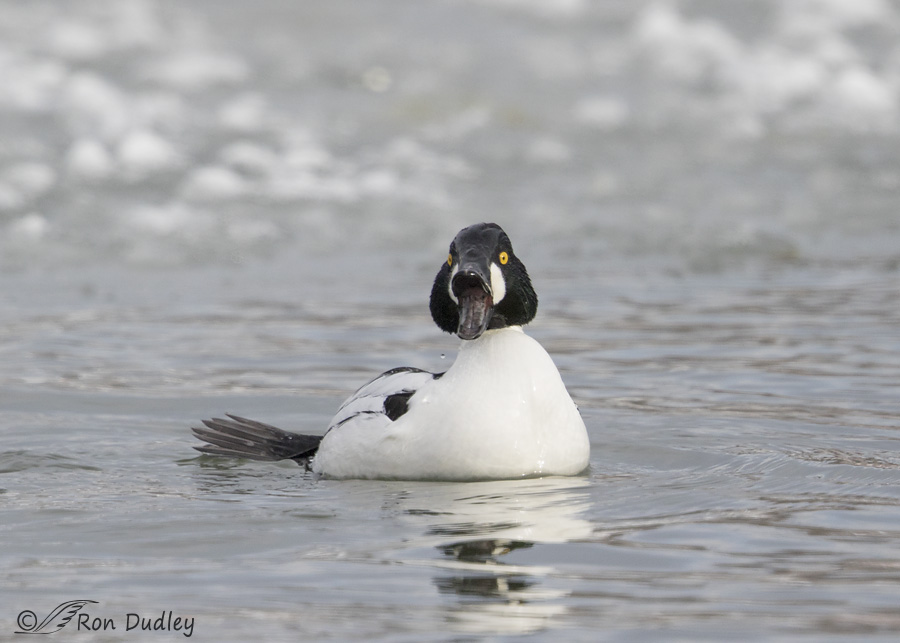
1/2500, f/6.3, ISO 500, Canon 7D Mark II, Canon EF 500mm f/4L IS II USM + EF 1.4 III Extender, not baited, set up or called in
He was at the edge of the ice (seen in the upper background) when he started to raise up…
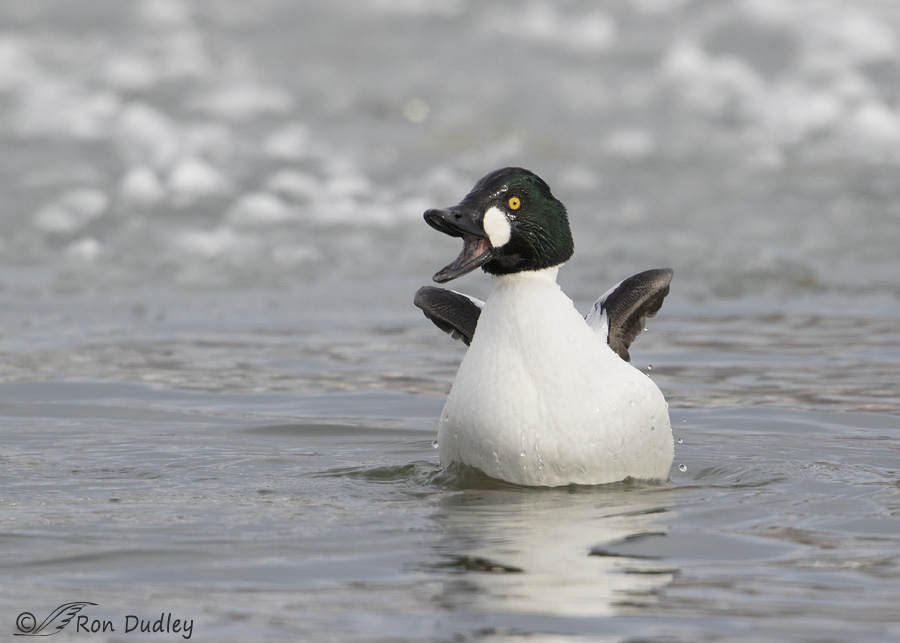
1/2500, f/6.3, ISO 500, Canon 7D Mark II, Canon EF 500mm f/4L IS II USM + EF 1.4 III Extender, not baited, set up or called in
and perform a wing flap. At this point I’d lost some of the light so the pretty glossy-green of the male’s head wasn’t very apparent during the entire performance.
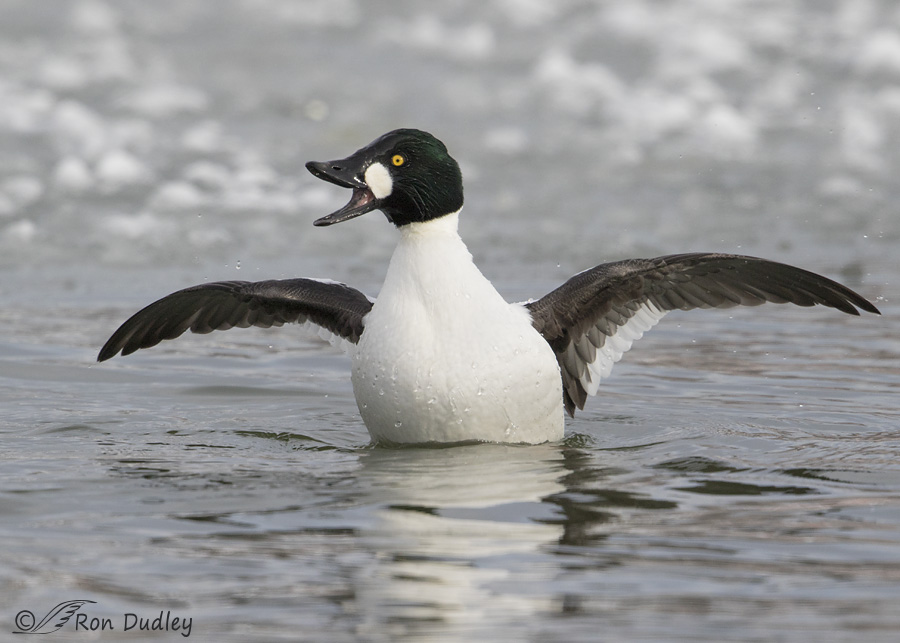
1/2500, f/6.3, ISO 500, Canon 7D Mark II, Canon EF 500mm f/4L IS II USM + EF 1.4 III Extender, not baited, set up or called in
But he put on quite a wing-flapping show.
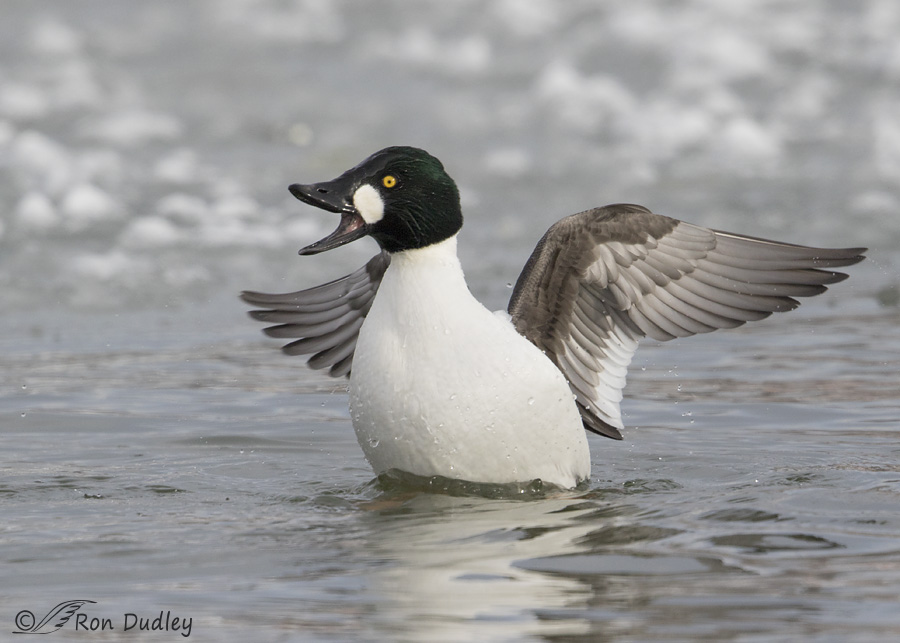
1/2500, f/6.3, ISO 500, Canon 7D Mark II, Canon EF 500mm f/4L IS II USM + EF 1.4 III Extender, not baited, set up or called in
I was able to catch his wings in a variety of positions.
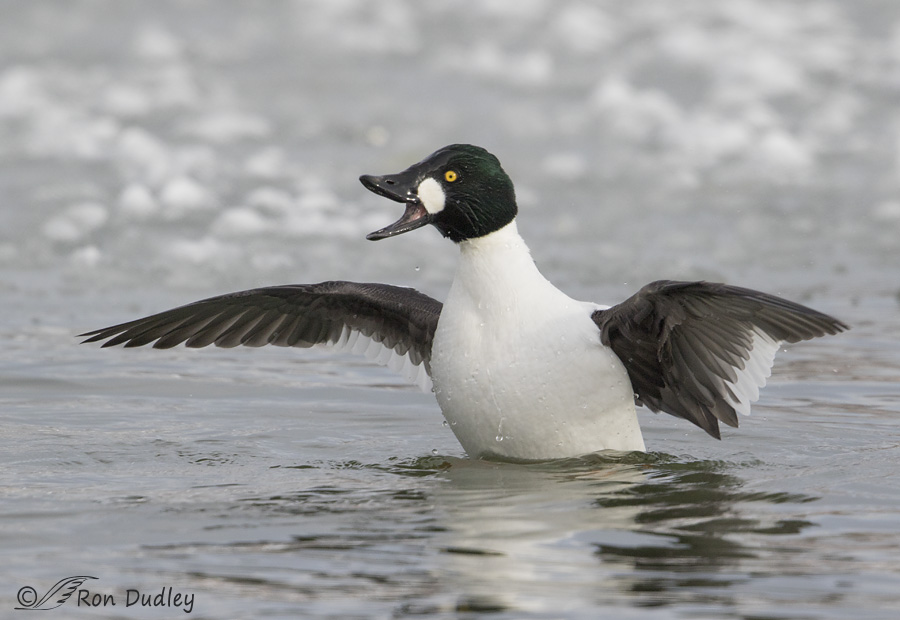
1/2500, f/6.3, ISO 500, Canon 7D Mark II, Canon EF 500mm f/4L IS II USM + EF 1.4 III Extender, not baited, set up or called in
Typically when I photograph a wing-flapping duck many of the poses are almost identical but…
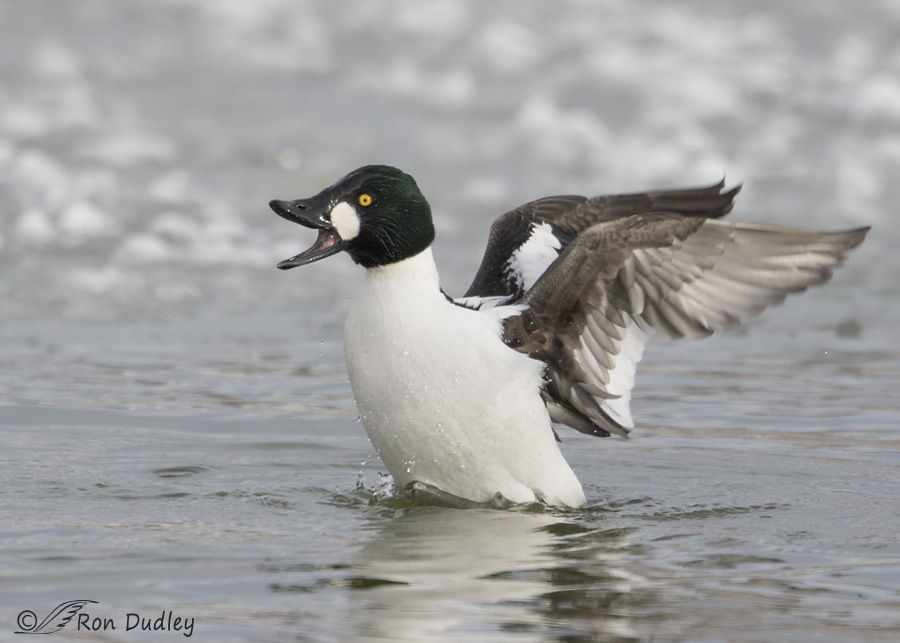
1/2000, f/6.3, ISO 500, Canon 7D Mark II, Canon EF 500mm f/4L IS II USM + EF 1.4 III Extender, not baited, set up or called in
this bird gradually rotated in the water during his performance so each pose was slightly different and I appreciated that.
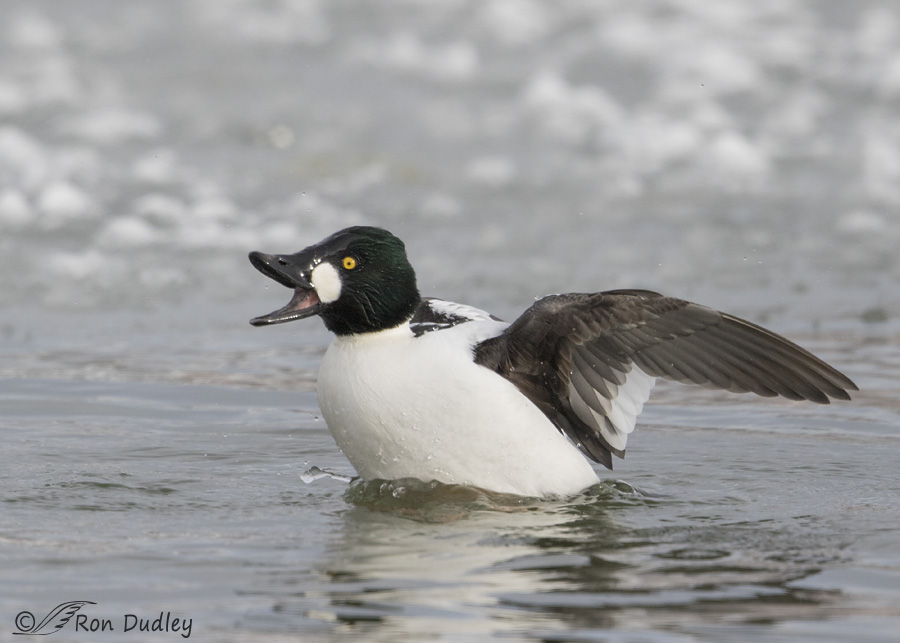
1/2000, f/6.3, ISO 500, Canon 7D Mark II, Canon EF 500mm f/4L IS II USM + EF 1.4 III Extender, not baited, set up or called in
Eventually he began to settle back down into the water…
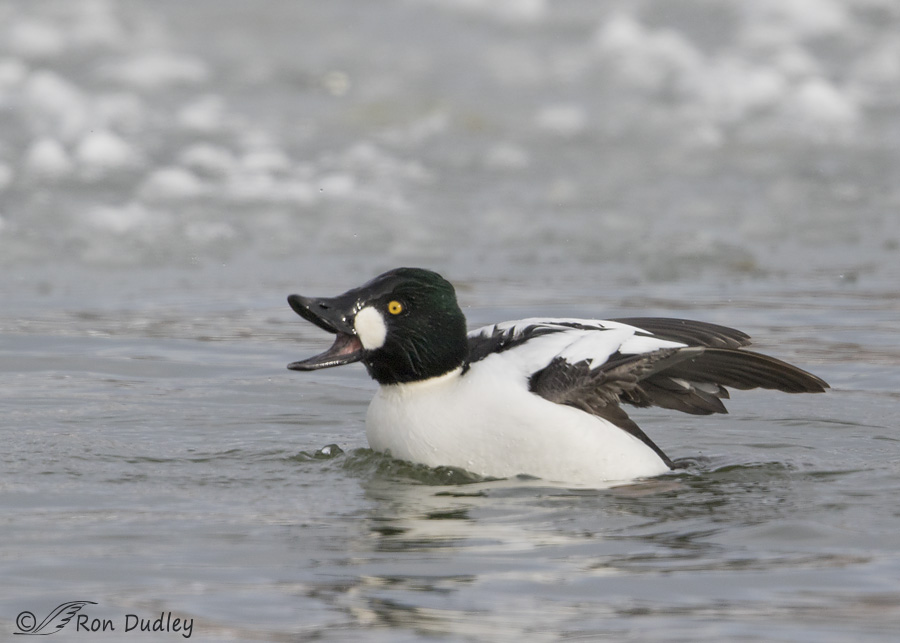
1/2500, f/6.3, ISO 500, Canon 7D Mark II, Canon EF 500mm f/4L IS II USM + EF 1.4 III Extender, not baited, set up or called in
and then the performance was over. But as you may have noticed there was something just a little unusual about this one.
He kept his beak wide open the entire time. I took 14 shots of him from the time he began to rise in the water to when he settled back down and his beak was wide open in every one of them. I’m almost positive he wasn’t vocalizing so keeping his beak open must have had some other behavioral significance. I photographed this bird and another immature male doing wing-flaps several different times and this was the only time either had their beaks open while they did it.
I’m not trying to make a mountain out of a mole hill but when I see something new like this it always makes me curious. Subtle behaviors often have significant meanings for birds and I enjoy at least trying to interpret them so I attempted to research this one but it turned up nothing.
But I still find it interesting whether I understand it or not.
Ron


He is yawning while he stretches.
Perhaps…? But he wasn’t stretching, his was flapping vigorously.
So much to learn. Always. Which is wonderful, frustrating, and sad. The sadness because I KNOW I will never learn it all.
How wonderful that this considerate bird pirouetted to show you ALL of his best sides.
Yup, he was a good bird, EC. Thank you.
Hi Ron,
I figured it out. The bird has a cousin like mine, who used to “grab” me when we were swimming as kids…😀
Yup, that HAS to be it, Dick!
Great shots Ron and an interesting observation. Sharp eye!
Charlotte
Thank you, Charlotte.
I, too, was curious about the open bill and wondered if he was vocalizing the whole time until I read your comments…then wondered if he felt vulnerable and was trying to look tough….
He sure kept it open for what seemed like a long time, Patty.
My 2 cents, open beak can be stress, but could it also be dominance? From my observations dominant behavior is usually very apparent.
Great shots, Ron, nice birds on the pond!
Dick, that bird certainly demonstrated dominance over the other male goldeneye at times…
What a glorious series. I wondered about the open-beak too. I’m CERTAIN that entire dance, if you will, means something, but what is a whole ‘nother question. And that brings to mind one of my all-time favorite quotes.
“The language of birds is very ancient, and like other ancient modes of speech, very elliptical; little is said but much is meant and understood.”
–Gilbert White, The Natural History and Antiquities of Selborne, 1778.
We’ve only recently come to the idea that other species could have language (among other things believed to be reserved to humans exclusively), so overall, we humans know little about the other languages, cultures and ways of life. And I know almost nothing about ducks 😉
That’s an insightful quote, Laura – especially for one about birds back in that day (239 years ago…).
I agree Ron. That’s one of the reasons it’s one of my all-time favorite quotes. So much of a critter’s language is unspoken in our way of thinking, but said in the subtle (or obvious) movements of the body, feathers (or fur, depending) and behavioral actions. I’m delighted that humans are studying these things and giving energy to translation and communication. We’re really all in this spinning rock experiment together!
The green sheen may not be widely present on his head, but it is quite visible in all but the first two photos. I’m not familiar with wing-flapping behavior except through what you post on your blog, but it does seem unusual that the bird’s beak is open. Definitely interesting behavior.
Thanks, Susan. I think so too.
In rehab, dealing with birds up close (waterbirds and otherwise) they will open their mouth with no vocalization due to stress or in a defensive posture (you are too close to my personal space) so with so many ducks in a small water space, they may all be at a heighten defense.
Could be, Pam.
But… I chose this series partly because there were no other birds in the frame with the goldeneye – meaning there weren’t any particularly close to him. In other instances where he did a wing flap and had birds closer (in the frame) he didn’t open his beak. Just sayin’…
Love that iridescent head! Another great series of images, Ron, and interesting behavior. I just took a quick look at my photos of wing-flapping ducks and none had their beaks open. Which proves – absolutely nothing! I like your notion of it being an aggressive thing.
Hope your new year is off to a great start!
“Which proves – absolutely nothing”
Yes, it proves nothing, Wally but it’s a valuable addition to the “evidence”. Thanks.
Fascinating behavioral series, Ron. You definitely have a knack for capturing birds doing weird stuff (for which we blog readers are very grateful)! 🙂
I wonder if the open beak might aid in the “intimidation factor” of the alert — a way to make him appear even larger and more of a force or ready to do battle with a gull. I wonder if the open beak is part of the species’ repertoire or more of an individual accommodation and unique to this particular bird. Of course, I have trouble figuring out why *I* do many of the things I do, so really, as far as this bird goes, I got nothin’.
An interesting possibility, Marty, though if that’s what was going on I suspect it was directed at the other male goldeneye rather than one of the gulls. This adult showed aggressive behavior (chasing) toward the immature male more than once.
Is it possible that birds can make a sound that we humans cannot hear? The only example off the top of my head is that Dogs hear sounds we don’t here, a high pitch sound. You mentioned a lot of birds present, thought this might be the case. If not, then I would like to add a little humor, the beak being open is saying “boy is this cold water”. Sorry about that, could not stop myself.
Steven, It may be possible but I’m not aware of any known examples.
And his beak was wide open all the time rather than partially opening and closing as is typical during vocalization (whether we could hear it or not).
In addition, Common Goldeneyes are “usually silent. Males appear to vocalize only during courtship” (from Birds of North America Online).
Wonderful series, Ron. 🙂 It is interesting that he had his beak open, but wasn’t vocalizing – perhaps just giving you a big “smile”? 🙂 It is stressful for the birds to be confined to a small area (tho great for predators at times) but does give the photographer a break of sorts.
There was lots of stress on that pond, Judy – mostly caused by the marauding gulls. It was also stressful for me because there were so many birds there that many of my potentially better shots were ruined by other birds in the frame. I’m not complaining though – it was still fun. And challenging!